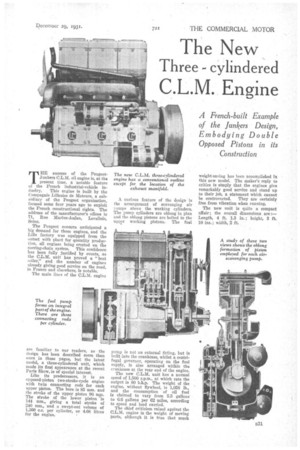The New
Page 45

If you've noticed an error in this article please click here to report it so we can fix it.
Three cylindered
C.L.M. Engine
A French-built Example of the Junkers Design, Embodying Double Opposed Pistons in its Construction
THE success of the PeugeotJunkers C.L.M. oil engine is, at the present time, a notable feature of the French industrial-vehicle in
dnary. This engine is built by the Compagnie Lilleoise de Moteurs, a subsidiary of the Peugeot organization, formed some four years ago to exploit the French constructional rights. The address of the manufacturer's offices is 71, Rue Marius-Aufan, Levallois, Seine.
The Peugeot concern anticipated a big demand for these engines, and the Lille factory was equipped from the outset with plant for quantity production, all engines being erected on tie moving-chain system. This confidence has been fully justified by events, as the C.L.M. unit has proved a "best seller," and the number of engines already giving good service on the road, in France and elsewhere, is notable.
The main lines of the C.L.M. engine are familiar to our readers, as the design has been described more than once in these pages, but the latest model, a three-cylindered unit, which made its first appearance at the recent Paris Show, is of special interest.
Like its predecessors, it is an opposed-piston two-stroke-cycle engine with twin connecting rods for each upper piston. The bore is 85 tom. and the stroke of the upper piston 96 ram. The stroke of the lower piston is 144 mm., giving a total stroke of 240 mm., and a swept-out volume of 1,360 c.c. per cylinder, or 4.08 litres for the engine. A curious feature of the design is the arrangement of scavenging air pumps above the working cylinders. The pump cylinders are oblong in plan and the oblong pistons are bolted to the upper working pistons. The fuel pump is not an external fitting, but is built into the crankcase, whilst a centrifugal governor, operating on the fuel supply, is also arranged within the crankcase at the rear end of the engine.
The new C.L.M. unit has a normal speed of 1,500 r.p.m., at which rate the output is 80 b.h.p. The weight of the engine, without flywheel, is 1,058 lb., and the consumption of oil fuel Is claimed to vary from 5.5 gallons to 6.6 gallons per 62 miles, according to speed and load carried.
The chief criticism raised against the engine is the weight of moving parts, although it is true that much weight-saving has been accomplished in this new model. The maker's reply to critics is simply that the engines give remarkably good service and stand up to their job, a statement which cannot
be controverted. They are certainly free from vibration when running.
The new unit is quite a compact affair; the overall dimensions are:— Length, 4 ft. 1.3 in.; height, 3 ft. 10 ins.; width, 2 ft.




























































































